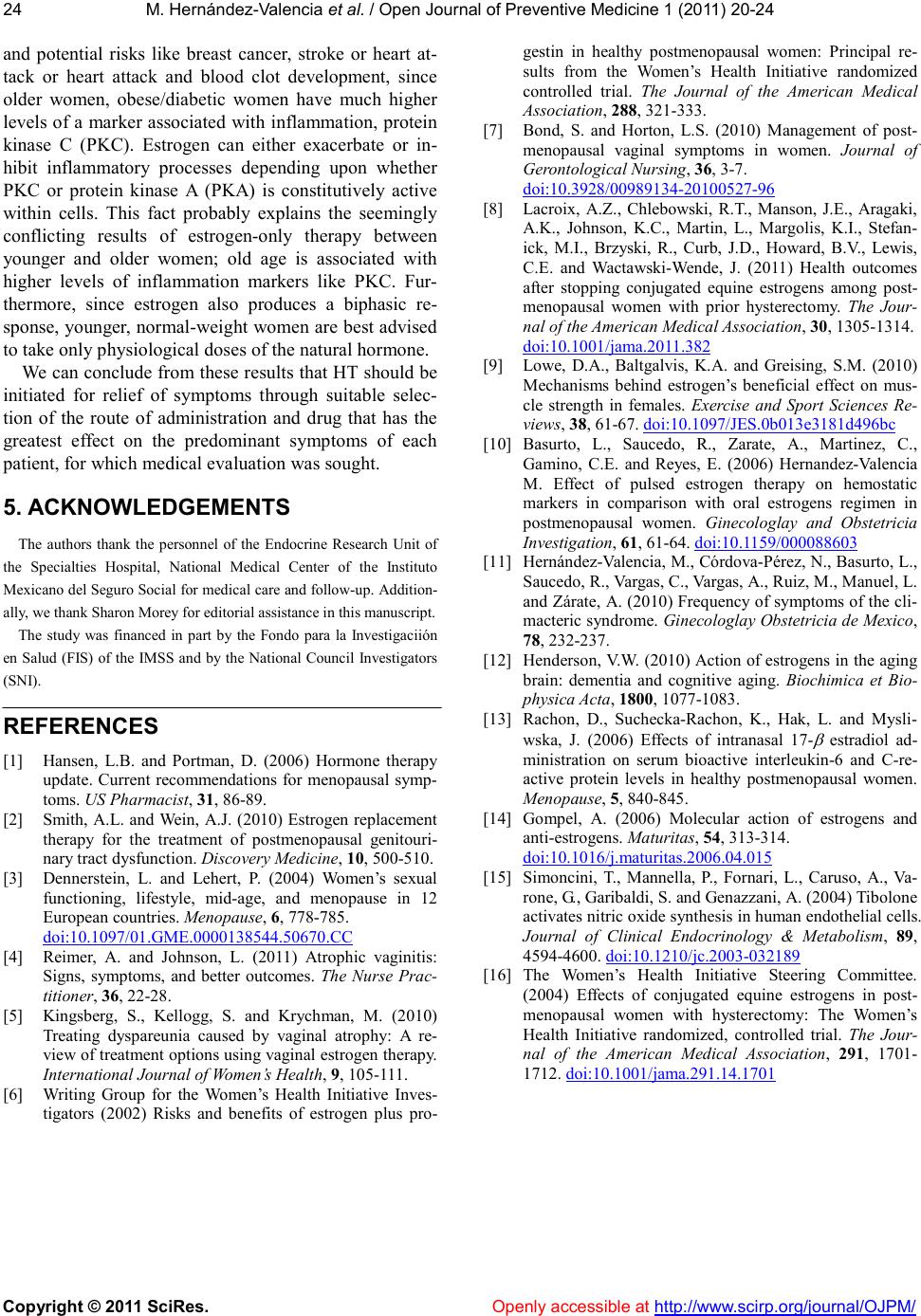
M. Hernández-Valencia et al. / Open Journal of Preventive Medicine 1 (2011) 20-24
Copyright © 2011 SciRes. http://www.scirp.org/journal/OJPM/
24
and potential risks like breast cancer, stroke or heart at-
tack or heart attack and blood clot development, since
older women, obese/diabetic women have much higher
levels of a marker associated with inflammation, protein
kinase C (PKC). Estrogen can either exacerbate or in-
hibit inflammatory processes depending upon whether
PKC or protein kinase A (PKA) is constitutively active
within cells. This fact probably explains the seemingly
conflicting results of estrogen-only therapy between
younger and older women; old age is associated with
higher levels of inflammation markers like PKC. Fur-
thermore, since estrogen also produces a biphasic re-
sponse, younger, normal-weight women are best advised
to take only physiological doses of the natural hor mone.
Openly accessible at
We can conclude from these results that HT should be
initiated for relief of symptoms through suitable selec-
tion of the route of administration and drug that has the
greatest effect on the predominant symptoms of each
pati ent , for whic h me d ica l eva l uati o n wa s soug ht.
5. ACKNOWLEDGEMENTS
The authors thank the personnel of the Endocrine Research Unit of
the Specialties Hospital, National Medical Center of the Instituto
Mexicano del Seguro Social for medical care and follow-up. Addition-
ally, we thank Sharon Morey for editorial assistance in this manuscript.
The study was financed in part by the Fondo para la Investigaciión
en Salud (FIS) of the IMSS and by the National Council Investigators
(SNI).
REFERENCES
[1] Hansen, L.B. and Portman, D. (2006) Hormone therapy
update. Current recommendations for menopausal symp-
toms. US Pharmacist, 31, 86-89.
[2] Smith, A.L. and Wein, A.J. (2010) Estrogen replacement
therapy for the treatment of postmenopausal genitouri-
nary tract dysfunction. Discovery Medici ne, 10, 500-510.
[3] Dennerstein, L. and Lehert, P. (2004) Women’s sexual
functioning, lifestyle, mid-age, and menopause in 12
European countries. Menopause, 6, 778-785.
do i:10.1097/01.GME.0000138544.50670.CC
[4] Reimer, A. and Johnson, L. (2011) Atrophic vaginitis:
Signs, symptoms, and better outcomes. The Nurse Prac-
titioner, 36, 22- 28.
[5] Kingsberg, S., Kellogg, S. and Krychman, M. (2010)
Treating dyspareunia caused by vaginal atrophy: A re-
view of treatment options using vaginal estrogen therapy.
Internat io nal J our n al of Women’s Health, 9, 105-111.
[6] Writing Group for the Women’s Health Initiative Inves-
tigators (2002) Risks and benefits of estrogen plus pro-
gestin in healthy postmenopausal women: Principal re-
sults from the Women’s Health Initiative randomized
controlled trial. The Journal of the American Medical
Association, 288, 321-3 33 .
[7] Bond, S. and Horton, L.S. (2010) Management of post-
menopausal vaginal symptoms in women. Journal of
Gerontological Nursing, 36, 3-7.
do i:10.3928/00989134-20100527-96
[8] Lacroix, A.Z., Chlebowski, R.T., Manson, J.E., Aragaki,
A.K., Johnson, K.C., Martin, L., Margolis, K.I., Stefan-
ick, M.I., Brzyski, R., Curb, J.D., Howard, B.V., Lewis,
C.E. and Wactawski-Wende, J. (2011) Health outcomes
after stopping conjugated equine estrogens among post-
menopausal women with prior hysterectomy. The Jour-
nal of the American Medical Association, 30, 1305-1314.
doi:10.1001/jama.2011.382
[9] Lowe, D.A., Baltgalvis, K.A. and Greising, S.M. (2010)
Mechanisms behind estrogen’s beneficial effect on mus-
cle strength in females. Exercise and Sport Sciences Re-
views, 38, 61-67. doi:10.1097/JES.0b013e3181d496bc
[10] Basurto, L., Saucedo, R., Zarate, A., Martinez, C.,
Gamino, C.E. and Reyes, E. (2006) Hernandez-Valencia
M. Effect of pulsed estrogen therapy on hemostatic
markers in comparison with oral estrogens regimen in
postmenopausal women. Ginecologlay and Obstetricia
Investigation, 61, 61-64. doi:10.1159/000088603
[11] Hernández-Valencia, M., Córdova-Pérez, N., Basu rto, L.,
Saucedo, R., Vargas, C., Vargas, A., Ruiz, M., Manuel, L.
and Zárate, A. (2010) Frequency of symptoms of the cli-
macteric synd rome. Gineco loglay Obstetri cia de Mexico,
78, 232- 237 .
[12] Henderson, V.W. (2010) Action of estrogens in the aging
brain: dementia and cognitive aging. Biochimica et Bio-
physica Ac ta, 1800, 1077- 1083.
[13] Rachon, D., Suchecka-Rachon, K., Hak, L. and Mysli-
wska, J. (2006) Effects of intranasal 17-
estradiol ad-
ministration on serum bioactive interleukin-6 and C-re-
active protein levels in healthy postmenopausal women.
Menopause, 5, 840-845.
[14] Gompel, A. (2006) Molecular action of estrogens and
anti-estrogens. Maturitas, 54, 313-314.
doi:10.1016/j.maturitas.2006.04.015
[15] Simoncini, T., Mannella, P., Fornari, L., Caruso, A., Va-
rone, G., Garibal di, S. and Genazzan i , A. (2004) Tibolone
activates nitric oxide synthesis in human endothelial cells.
Journal of Clinical Endocrinology & Metabolism, 89,
4594-4600. doi:10.1210/jc.2003-032189
[16] The Women’s Health Initiative Steering Committee.
(2004) Effects of conjugated equine estrogens in post-
menopausal women with hysterectomy: The Women’s
Health Initiative randomized, controlled trial. The Jour-
nal of the American Medical Association, 291, 1701-
1712. doi:10.1001/jama.291.14.1701